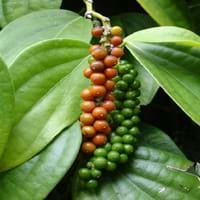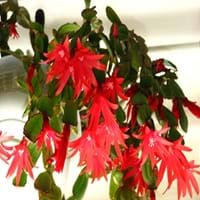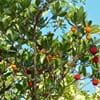Life Span
Perennial
Perennial
Type
Broadleaf Evergreen, Vines
Cactus or Succulent
Origin
India, Indonesia, Southeast Asia, Southern Asia
South America, Brazil
Types
Red pepper, Orange pepper
Not Available
Number of Varieties
Not Available
Habitat
Moist Soils, orchards, Temperate Regions
Rocky areas, Terrestrial, Tropical regions
USDA Hardiness Zone
8-15
11-12
AHS Heat Zone
12 - 1
12-1
Sunset Zone
H1, H2, 8, 9, 14, 15, 16, 17, 18, 19, 20, 21, 22, 23, 24
16, 17, 21, 22, 23, 24
Habit
Clump-Forming
Prostrate/Trailing
Minimum Width
Not Available
Flower Color
Lemon yellow
Red, Magenta, Crimson
Flower Color Modifier
Bicolor
Not Available
Fruit Color
Red, Green, Light Green
Non Fruiting Plant
Leaf Color in Spring
Light Green, Dark Green
Not Available, Pale Green
Leaf Color in Summer
Light Green
Dark Green
Leaf Color in Fall
Light Green, Dark Green
Dark Green
Leaf Color in Winter
Light Green, Dark Green
Dark Green
Leaf Shape
Circular cordate
Succulent
Plant Season
Spring, Summer, Fall, Winter
Spring, Winter
Sunlight
Full Sun, Partial Sun, Partial shade
Full Sun
Type of Soil
Loam, Sand
Loam, Sand
The pH of Soil
Acidic, Neutral, Alkaline
Neutral
Soil Drainage
Average
Well drained
Bloom Time
Not Available
Early Spring, Winter, Late Winter
Tolerances
Drought
Heat And Humidity, Heat Tolerance
Where to Plant?
Container, Ground
Container, Ground, Pot
How to Plant?
Seedlings, Stem Planting, Vegetative Reproduction
Stem Planting
Plant Maintenance
Medium
Low
Watering Requirements
Do Not over Water, Sprinkle water over foliage, Water every two or three days during warmer months
Do Not over Water, Keep the ground moist but not water-logged, Never Over-water, Requires consistently moist soil, Requires regular watering, Requires watering in the growing season, Water more in summer
In Summer
Lots of watering
Ample Water
In Spring
Moderate
Ample Water
In Winter
Average Water
Average Water
Soil pH
Acidic, Neutral, Alkaline
Neutral
Soil Type
Loam, Sand
Loam, Sand
Soil Drainage Capacity
Average
Well drained
Sun Exposure
Full Sun, Partial Sun, Partial shade
Full Sun
Pruning
A hard prune may be necessary if the plant becomes woody, Remove dead branches, Trim each shoot back to the first set of leaves
Remove damaged leaves, Remove dead leaves, Remove dead or diseased plant parts
Fertilizers
10-10-10 diluted liquid fertilizer, All-Purpose Liquid Fertilizer, Do not let fertilizers touch the leaves
All-Purpose Liquid Fertilizer, fertilize in growing season, fertilize in spring
Pests and Diseases
Aphids, Beetles, Root rot, Rust, Scab
Bacterial Diseases, Fungal Diseases, Red blotch
Plant Tolerance
Heat Tolerance, Humidity, Salt and Soil Compaction
Heat And Humidity, Heat Tolerance
Flowers
Not Available
Showy
Flower Petal Number
Single
Single, Semi-Double
Foliage Texture
Medium
Bold
Foliage Sheen
Matte
Not Available
Attracts
Aphids, Leafminer, Snails, Squirrels
Hummingbirds
Allergy
Oral Allergy
breathing problems
Aesthetic Uses
Beautification, Cottage Garden, Decorating walls
Beautification, Landscape Designing, Showy Purposes
Beauty Benefits
Acne, Blackheads
No Beauty Benefits
Environmental Uses
Fixes Nitrogen, Insect Repellent
Air purification, Indoor Air Purification
Medicinal Uses
Acid Reflux, Dysentry, Healthy teeth, Inflammation, Oral health
No Medicinal Use
Part of Plant Used
Dried seeds
Leaves
Other Uses
Culinary use, Oil is used for aromatherapy, Used in herbal medicines
Decoration Purposes, Showy Purposes, Used as Ornamental plant
Used As Indoor Plant
Yes
Yes
Used As Outdoor Plant
Yes
Yes
Garden Design
Container, Feature Plant, Hedges, Screening / Wind Break, Tropical
Container, Hanging Basket, Houseplant, Tropical
Botanical Name
Piper nigrum
Hatiora gaertneri
Common Name
Peppercorn, Piper, Black pepper
Whitsun cactus
In Hindi
काली मिर्च
ईस्टर कैक्टस
In German
Pfeffer
Osterkaktus
In French
Piper nigrum
cactus de Pâques
In Spanish
Poivrier noir
cactus de Pascua
In Greek
μαύρο πιπέρι
Πάσχα κάκτος
In Portuguese
Pimenta-preta
cacto Páscoa
In Polish
Pieprz czarny
Wielkanocny kaktus
In Latin
nigrum piperis
Pascha Cactus
Phylum
Magnoliophyta
Tracheophyta
Class
Magnoliopsida
Magnoliopsida
Order
Piperales
Caryophyllales
Family
Piperaceae
Cactaceae
Clade
Angiosperms, Monocots
Angiosperms, Core eudicots, Eudicots
Tribe
Not Available
Rhipsalideae
Subfamily
Not Available
Cactoideae
Number of Species
Not Available
Not Available
Importance of Black pepper and Easter cactus
Want to have the most appropriate plant for your garden? You might want to know the importance of Black pepper and Easter cactus. Basically, these two plants vary in many aspects. Compare Black pepper and Easter cactus as they differ in many characteristics such as their life, care, benefits, facts, etc. Every gardener must at least have the slightest clue about the plants he wants to plant in his garden. Compare their benefits, which differ in many ways like facts and uses. The medicinal use of Black pepper is Acid Reflux, Dysentry, Healthy teeth, Inflammation and Oral health whereas of Easter cactus is No Medicinal Use. Black pepper has beauty benefits as follows: Acne and Blackheads while Easter cactus has beauty benefits as follows: Acne and Blackheads.
Compare Facts of Black pepper vs Easter cactus
How to choose the best garden plant for your garden depending upon its facts? Here garden plant comparison will help you to solve this query. Compare the facts of Black pepper vs Easter cactus and know which one to choose. As garden plants have benefits and other uses, allergy is also a major drawback of plants for some people. Allergic reactions of Black pepper are Oral Allergy whereas of Easter cactus have breathing problems respectively. Having a fruit bearing plant in your garden can be a plus point of your garden. Black pepper has no showy fruits and Easter cactus has no showy fruits. Also Black pepper is not flowering and Easter cactus is not flowering . You can compare Black pepper and Easter cactus facts and facts of other plants too.





